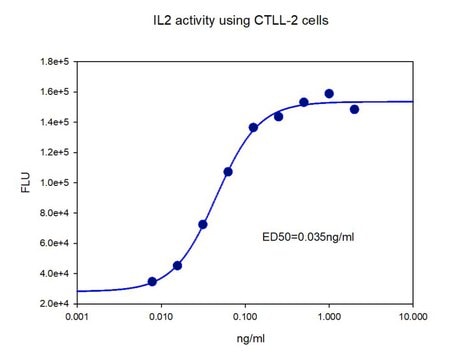Products may be shipped at a different temperature than the recommended long-term storage temperature. If the product quality is sensitive to short-term exposure to conditions other than the recommended long-term storage, it will be shipped on wet or dry-ice. If the product quality is NOT affected by short-term exposure to conditions other than the recommended long-term storage, it will be shipped at ambient temperature. As shipping routes are configured for minimum transit times, shipping at ambient temperature helps control shipping costs for our customers. For more information, please refer to the Storage and Transport Conditions document: https://www.sigmaaldrich.com/deepweb/assets/sigmaaldrich/marketing/global/documents/316/622/storage-transport-conditions-mk.pdf
SBR00013
Actinomycin D, Ready Made Solution
from Streptomyces sp., 2 mg/mL in DMSO
Sinónimos:
Actinomycin D solution from Streptomyces sp., Actinomycin IV, Dactinomycin
About This Item
Productos recomendados
origen biológico
Streptomyces sp.
Nivel de calidad
descripción
Ready Made Solution
Formulario
liquid
condiciones de almacenamiento
protect from light
concentración
2 mg/mL in DMSO
color
dark orange
espectro de actividad antibiótica
neoplastics
Modo de acción
DNA synthesis | interferes
temp. de almacenamiento
−20°C
cadena SMILES
N21C(CCC2)C(=O)N(CC(=O)N(C(C(=O)OC(C(C(=O)NC(C1=O)C(C)C)NC(=O)c3c4nc5c(c([c](c(c5[o]c4c(cc3)C)C)=O)N)C(=O)NC6C(OC(=O)C(N(C(=O)CN(C(=O)C7N(CCC7)C(=O)C(NC6=O)C(C)C)C)C)C(C)C)C)C)C(C)C)C)C
InChI
1S/C62H86N12O16/c1-27(2)42-59(84)73-23-17-19-36(73)57(82)69(13)25-38(75)71(15)48(29(5)6)61(86)88-33(11)44(55(80)65-42)67-53(78)35-22-21-31(9)51-46(35)64-47-40(41(63)50(77)32(10)52(47)90-51)54(79)68-45-34(12)89-62(87)49(30(7)8)72(16)39(76)26-70(14)58(83)37-20-18-24-74(37)60(85)43(28(3)4)66-56(45)81/h21-22,27-30,33-34,36-37,42-45,48-49H,17-20,23-26,63H2,1-16H3,(H,65,80)(H,66,81)(H,67,78)(H,68,79)
Clave InChI
RJURFGZVJUQBHK-UHFFFAOYSA-N
¿Está buscando productos similares? Visita Guía de comparación de productos
Categorías relacionadas
Aplicación
<li><strong>Regulation of Immune Checkpoints in Cancer:</strong> Actinomycin D is pivotal in studying the ADAR-mediated RNA editing processes that regulate PVR immune checkpoints in colorectal cancer, thus demonstrating its crucial role in cancer immunotherapy research and providing insights into novel therapeutic targets (Qian et al., 2024).</li>
<li><strong>Chemotherapy and Immunotherapy Combination:</strong> The use of Actinomycin D in combined chemotherapy highlights its effectiveness in salvaging multi-chemotherapy agent and avelumab resistant choriocarcinoma, showcasing its potential in overcoming resistance to treatment in gynecological cancers (Lehmann et al., 2023).</li>
<li><strong>Advancements in Dental Medicine:</strong> Actinomycin D is used in regulating gene expression crucial for tissue regeneration and repair in dental health and it is also used to determine RNA stability assay (Pan et al., 2023).</li>
<li><strong>Cancer Progression Research:</strong> The study on hypoxia-induced lncRNA in hepatocellular carcinoma progression, where RNA-binding proteins play a critical role, aligns with Actinomycin D′s application in transcriptional inhibition and its influence on mRNA stability, essential for understanding cancer biology and developing targeted therapies (Tuo et al., 2023).</li>
</ul>
Acciones bioquímicas o fisiológicas
Actinomycin D has been shown to be an inhibitor of the minus-strand transfer step in reverse transcription,[5][6] and is therefore used in studies and suppression of HIV-replication. It has also been shown to suppress programmed cell death of PC12 cells induced by etoposide, an inhibitor of topoisomerase II.[7]
In cell culture, actinomycin D is used as a selection agent. Actinomycin D binding to yeast in ribosomal RNA has been studied.[8] The sensitivity of various strains of E. coli to actinomycin D and the mechanism of binding has been studied.[9][10] Actinomycin D is also used in molecular biology as a DNA intercalator which blocks the progression of RNA polymerases.[11]
Envase
Precaución
Nota de preparación
Palabra de señalización
Danger
Frases de peligro
Consejos de prudencia
Clasificaciones de peligro
Carc. 1B
Código de clase de almacenamiento
6.1C - Combustible acute toxic Cat.3 / toxic compounds or compounds which causing chronic effects
Clase de riesgo para el agua (WGK)
WGK 3
Punto de inflamabilidad (°F)
188.6 °F - closed cup
Punto de inflamabilidad (°C)
87 °C - closed cup
Elija entre una de las versiones más recientes:
Certificados de análisis (COA)
¿No ve la versión correcta?
Si necesita una versión concreta, puede buscar un certificado específico por el número de lote.
¿Ya tiene este producto?
Encuentre la documentación para los productos que ha comprado recientemente en la Biblioteca de documentos.
Los clientes también vieron
-
How is shipping temperature determined? And how is it related to the product storage temperature?
1 answer-
Helpful?
-
-
How can I determine the shelf life / expiration / retest date of this product?
1 answer-
If this product has an expiration or retest date, it will be shown on the Certificate of Analysis (COA, CofA). If there is no retest or expiration date listed on the product's COA, we do not have suitable stability data to determine a shelf life. For these products, the only date on the COA will be the release date; a retest, expiration, or use-by-date will not be displayed.
For all products, we recommend handling per defined conditions as printed in our product literature and website product descriptions. We recommend that products should be routinely inspected by customers to ensure they perform as expected.
For products without retest or expiration dates, our standard warranty of 1 year from the date of shipment is applicable.
For more information, please refer to the Product Dating Information document: https://www.sigmaaldrich.com/deepweb/assets/sigmaaldrich/marketing/global/documents/449/386/product-dating-information-mk.pdfHelpful?
-
Active Filters
Nuestro equipo de científicos tiene experiencia en todas las áreas de investigación: Ciencias de la vida, Ciencia de los materiales, Síntesis química, Cromatografía, Analítica y muchas otras.
Póngase en contacto con el Servicio técnico








